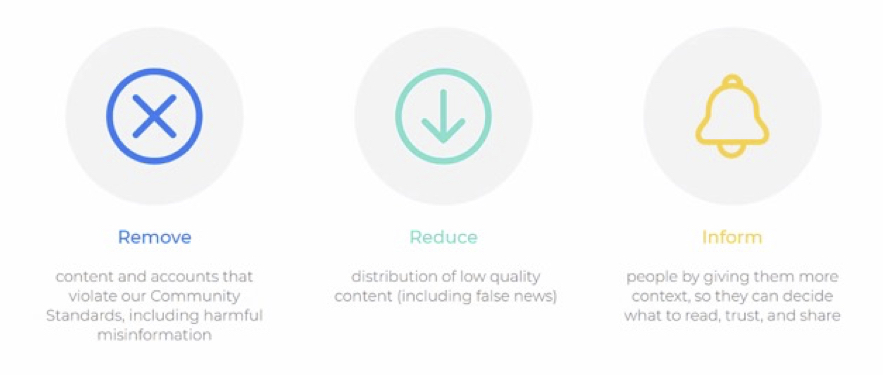The theoretical metaphor of media ecology argues that media outlets are like species that live and interact in an ecosystem. As in any ecosystem, one change impacts the whole environment. For example, the crisis of the print and broadcast media, the rise of the Internet and social media platforms have changed the media system and the ways in which people communicate, entertain and inform themselves in what Prior (2007) describes as a high-choice media environment. From my perspective, yesterday’s session dealt exactly with that: what has changed in today’s media ecology, what has remained stable and how media professionals – such as Facebook employers and journalists – tackle and contest those changes in order to preserve information as a public good.
Yesterday´s speakers showed us that in this “new” environment, social networks have been subjected to informative standards while journalism has been forced to lower its standards in order to get more clicks and increase revenues. In the midst of all these transformations, the tension between the rights of a free press and the right to a fair trial remain more or less stable with an ongoing dispute between technological tools for live transmission and the juror’s responsibility of preventing a trial by the media. By stretching a bit more the environmental analogy I will now proceed to describe briefly the three segments that made up yesterday’s session.
Managing pollution: Facebook’s strategy to prevent mis/disinformation on COVID-19 vaccines
Jessica Zucker is the Head of Health Misinformation Policy at Facebook. She describes three strategies for managing mis/disinformation and other types of harmful content: remove, reduce and inform. These strategies interact to achieve a balance between freedom of expression and providing a safe space for discussing important issues online. Like waste management, which is based on reduce, reuse and recycle, Facebook’s strategy to tackle mis/disinformation related to COVID-19 vaccines aims to decrease pollution in the media ecosystem. In order to do so, collaboration is key. In this particular case, Jessica explained how Facebook works with fact-checkers to identify and contain health related mis/disinformation. In my opinion, this shows that social media platforms now have to be compiled to the same informative standards of accountability, truth and accuracy once held exclusively to print newspapers.
Ecosystem equilibrium: ensuring a public and speedy trial while preventing a trial by media
The role that communication technologies play in this fragile equilibrium
Mr. Barr’s lecture began by remembering the tradition of public trials which goes back to colonial America. The main goal of a public trial is to assure that people are being prosecuted fairly. However, sometimes media coverage can disturb the fragile equilibrium between the constitutional rights of a free press and the right to a fair trial in the U.S. One thing that I found fascinating from Mr. Barr’s presentation was the role of communication technologies in the transmission of a trial and how their use can prevent a person from having an impartial jury. Mr. Barr mentioned high-profile cases such as the trial for the kidnapping of Charles Lindbergh’s baby and the OJ Simpson trial. In both cases, the presence of the media tilted the equilibrium and the outcome of the trial. This information prompted SUSI scholars to compare the way in which the presence of the media in a courthouse is handled in their home countries. Participants shared their point of views in the chat and that got me thinking about the presence of TV cameras and reporters in a courthouse. That is something that we take for granted, like water and clean air, but that needs to be properly catered if we want to maintain an equilibrium between the access to information and a person’s right to the presumption of innocence.
Harvesting rights in a toxic land: advocating for labor rights in media corporations
Rebekah Sanders, the president of the Arizona Republic Guild, shared with us the inspiring story behind the creation of the union of reporters at The Arizona Republic newspaper. As with many other newsrooms around the world, Rebekah and her colleagues faced the pressure of corporate interests over journalistic practices and felt the urge to challenge and protect the quality of their job and their labor rights from the predatory market practices that undermine the role of journalism as a public good. By unionizing, these reporters guaranteed themselves a voice in the decision making process of the newspaper and more importantly, they strengthened their bond as a community with common interests, hopes and struggles.

One of those struggles relates to the future of journalism and the so-called “crisis of the newspaper model.” Rebekah argued that what is not working is the newspaper model designed by media corporations, but that other strategies may be more effective. For instance, she explained that subscription is a way of ensuring high-quality journalism that also rewards creativity, innovation and quality. In my opinion, this shows how collective action can make a positive impact in the media ecosystem.

In conclusion, yesterday´s session showed us that balance is needed to ensure a healthy media ecology in which high quality information can serve as a cornerstone of democracy.
